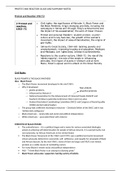Summary
Summary All Protest and Reaction notes
- Course
- Institution
- Book
29 page document containing all notes for Key Topic 2: Protest and Reaction 1963-72, all sections covered: Civil Rights, Johnson's great society, Protest and Personal Freedom, Reactions to counter culture. These were the notes I used to achieve A*in History A-Level.
[Show more]




